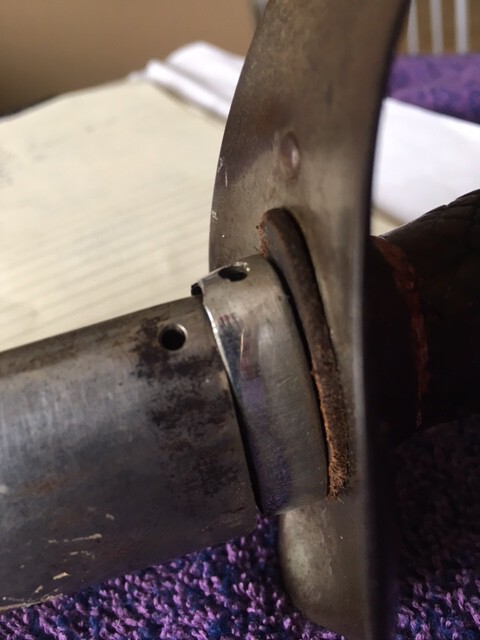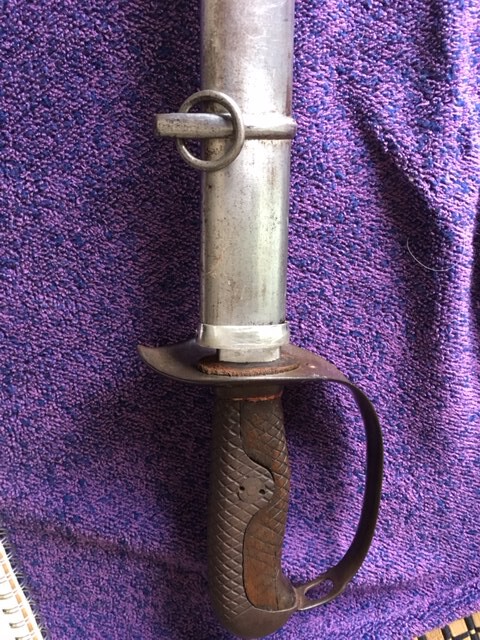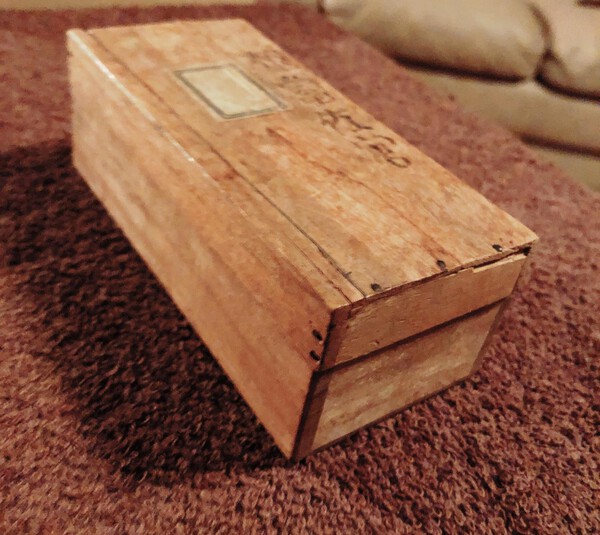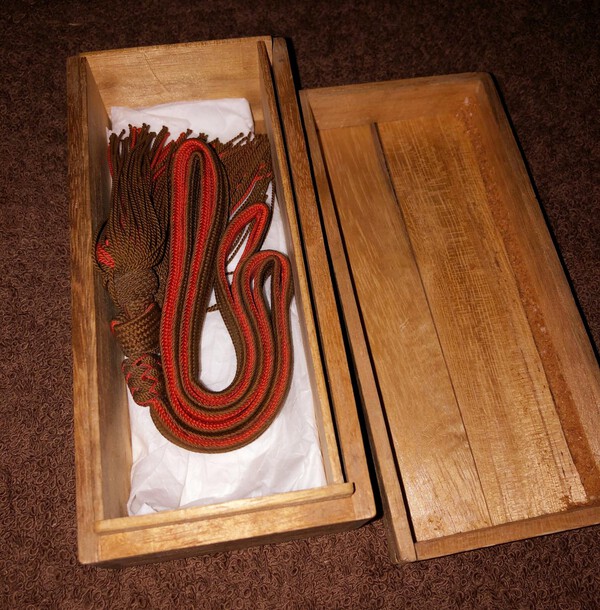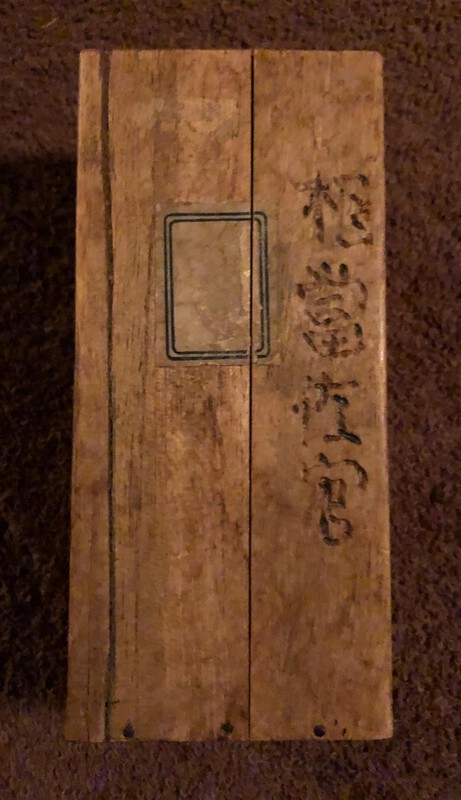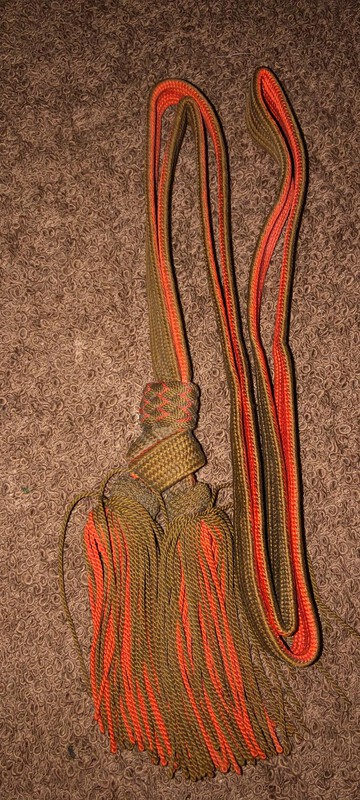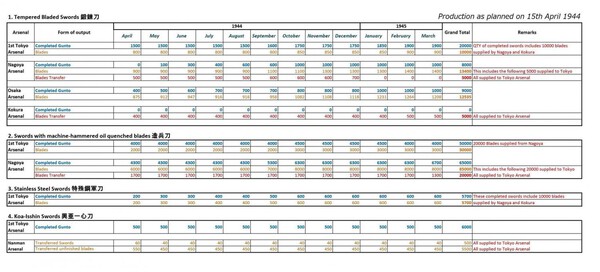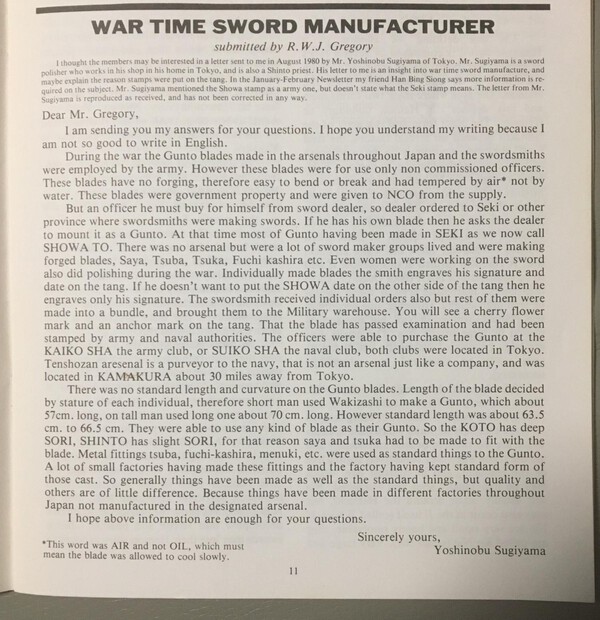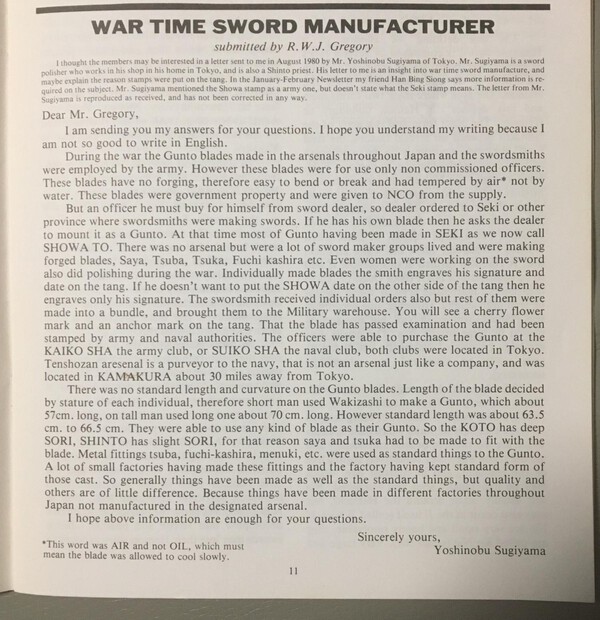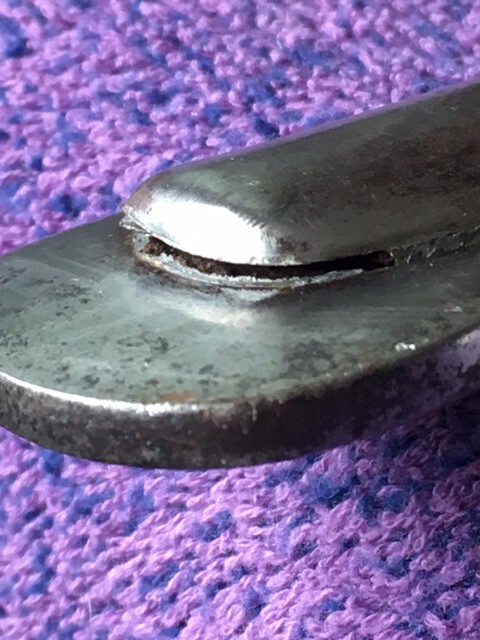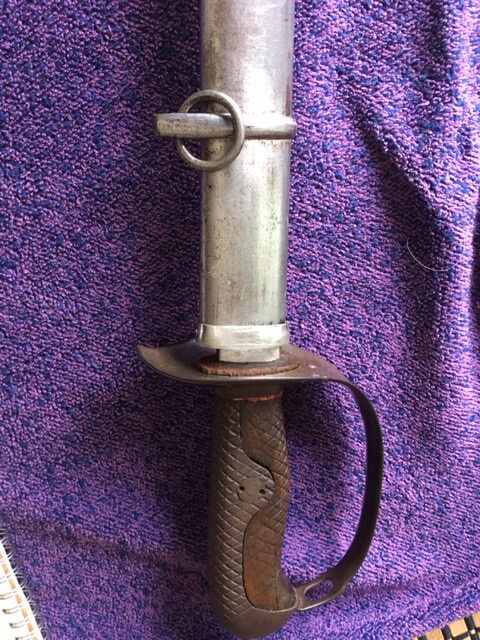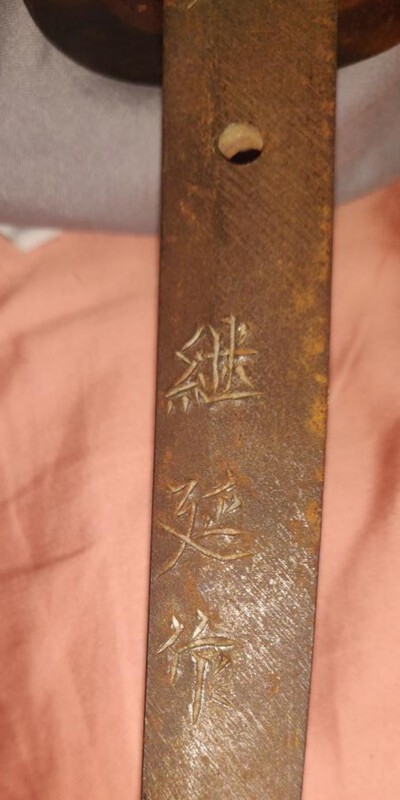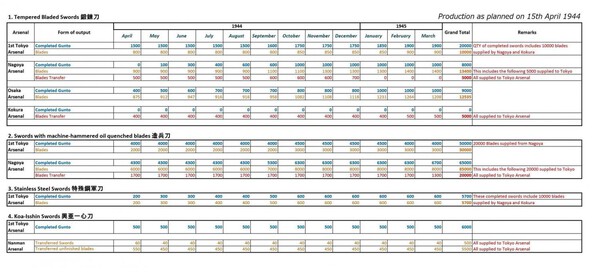-
Posts
13,032 -
Joined
-
Last visited
-
Days Won
155
Content Type
Profiles
Forums
Events
Store
Downloads
Gallery
Everything posted by Bruce Pennington
-

NEW SOFTWARE and UPDATES
Bruce Pennington replied to Brian's topic in Forum Technical Details and Maintenance
Love it Brian, really nice job! Wondering if we're getting more personal conversation storage? I'm at 86%. Do I need to go through old PM's and delete stuff? Thanks! -

Verification of Japanese Sword Kyu gunto type 19
Bruce Pennington replied to AjschulerA's topic in Military Swords of Japan
-
Here ya go John! I've long since lost the little rubber band that was binding the tassel. Maybe you should submit your treatise to the JSSUS newsletter. They're looking for articles.
-
Updates on the topic from Nick at: http://www.warrelics.eu/forum/Japanese-militaria/legally-rebutting-existence-type-3-army-officers-sword-708745/ New info: - Tojo tried to get the model launched in 1941 with a press release and ordered 3,000 per year made. - Appearantly didn't happen, speculating lack of demand due to appearance - 1943, due to shortages of copper/brass, army pushed the Contingency model and production expanded.
-
Oh! First one (you must know this because you said it's Muromachi) is "A day in August, 1512" I'll step aside for the rest!
-
There are many great dealers listed on the top of each forum under "Links" here: http://www.nihontomessageboard.com/links.html
-
WOW! Thanks for finding that! I had originally googled to see if the movie was based on any facts, but mistakenly only read the Wiki on the movie, which didn't address the question at all. After watching this, I found a great page about Brunet, which discussed his adventure and gave some more details than the video gives. here: https://allthatsinteresting.com/last-samurai-true-story-jules-brunet#:~:text=Not%20many%20people%20know%20the,use%20modern%20weapons%20and%20tactics.
-
A good number of unused tassels made it into the collecting world from the war. I recently bought an unused Field grade tassel, still folded, rubber-banded, in it's original box.
-
Dang, you guys keep trying to make me learn stuff! So, the 95 blade is as hard as it can get, then tempered (by air) to increase flexability while retaining edge hardness, right? But likely no hamon, since no use of clay in the tempering.
-
David, According to this 1943 War Ministry General Order - "Rikugunshō 陸軍省 [War Ministry]. Rikugun Heiki Gyōsei Honbu 陸軍兵器行政本部 [Army Ordnance Administration Headquarters]. Ken’in oyobi hyōshiki kitei 檢印及標識規定 [Regulations for Inspection Marks and Signs]. General Order 2389. 19 October 1943." - the stamp is of the "阪 saka 大阪陸軍造兵廠監督課 Ōsaka Army Arsenal Supervisory Section" The debate on "acceptance", which would include gendaito/nihonto, vs a mark of non-traditionally made blade is unresolved. I suspect the answer is "BOTH". Like your Gassan example, there are others who know of Showa stamped blades that were papered at shinsa (don't know if the stamp was removed). We can safely say it was an "inspection" stamp. Now if the inspector at Osaka Army Arsenal accepted a donated nihonto (or part of the purchase program) and put his mark on the nakago mune, it's certainly possible. It would be the only way to explain such examples. The stamps on RJT blades seem to be there for the same purpose, for we know Star-stamped RJT blades were gendaito. I've just started my search for Saka stamps, so I'll update what I find as to type of blade, and location on the nakago.
-
Thanks to Niel (IJASWORDS), we now have a stamp survey done by Malcolm E. Cox, published in a JSSUS newsletter. Master Cox was fortunate enough to survey 425 blades! Half, 213, had stamps. I've added his data to mine and made the following chart. The majority of blades in my survey are signed, but like the Cox survey, most are not dated. Cox didn't discuss smith mei in his report. You can see a small overlap in years 1940/1941 with the Showa and Seki stamps, but the real switch came in 1942 when the Army took centralized control of all sword production, ending the Showa stamp (except the rare 1945 blades!) and moving to the Seki stamp, followed by the Gifu stamp. I've just added the Saka stamp and only have 1 example. Since my interest began in blade stamps, I haven't seen many Saka stamps, but it surprises me as we have recently learned that the Osaka Arsenal was making more blades than Mantetsu as seen in this translated chart from 1944 blade production.
-

Help for Someone with an RJT blade
Bruce Pennington replied to Bruce Pennington's topic in Translation Assistance
Excellent, thanks guys! It in beat-up Rinji-seishiki fittings, but it's clear they were higher quality originally, for the star-stamped blade. here: https://www.wehrmacht-awards.com/forums/forum/ken-jasper-international-militaria-forums/Japanese-militaria-forum/11704944-Japanese-sword-info-who-used-me -
An interesting point made in a letter from a WWII polisher: NCO blades were "tempered by air, not by water". I'm not a metals buy, but I suspect that this means the edges really weren't tempered at all right? Letter provided by Neil (IJASWORDS), found in a JSSUS newsletter.
-

Attention Mantetsu Owners: A Survey
Bruce Pennington replied to Bruce Pennington's topic in Military Swords of Japan
I think you nailed it JP. Neil (IJASWORDS) just dug out an article from JSSUS that included a letter from a WWII era polisher to Robert Gregory. In it, he says swords were bundled and sent to an Army warehouse in Tokyo and distributed to the Army and Navy clubs for sale! A couple of other points from the letter: 1. NCO blades were "air" cooled, not water or oil 2. Custom orders were made to fit the height of the buyer, and wakizashi were used along with every other length -

Verification of Japanese Sword Kyu gunto type 19
Bruce Pennington replied to AjschulerA's topic in Military Swords of Japan
Thanks mate! Didn't know they could move, but I've only had 2 in-hand and have never studied them. Now that you mention it, one of my Type 32s, an Otsu, is in a Type 19 saya that too short. Some Bubba actually shoved the blade into the saya so hard, the tip split the end of the saya. -
-

Verification of Japanese Sword Kyu gunto type 19
Bruce Pennington replied to AjschulerA's topic in Military Swords of Japan
Hamish, Forgive my inexperience, but isn't the ashi too close to the saya throat? -

Attention Mantetsu Owners: A Survey
Bruce Pennington replied to Bruce Pennington's topic in Military Swords of Japan
Nick Komiya, Warrelics, made a full translation of the 1944 sword production chart we saw earlier. Points of interest: 1. It confirms what we've always heard that Kokura wasn't making/finishing blades, simply inspecting and tranfering them. 2. In the Koa Isshin block at the bottom, it lists "Nanman" not SMR or Mantetsu. The 50-60 finished blades per month is evidence that Nanman was at least finishing Mantetsu blades (Koa Isshin blades!). But as the supervisory arsenal over SMR, this list could simply be listing the Koa's supplied to them BY SMR and transfered (like Kokura). But, the rest of the chart shows the arsenals were making blades (except Kokura). Using that same standard, this chart must be showing than Nanman was making them too (50-60). 3. I find the Osaka block interesting. I had read that the Osaka arsenal was producing blades, but other than the rare "Saka" stamped blades, we almost never see them. Yet, they were making more blades that Mantetsu. I wonder why the large number of blades were transfered to Tokyo? It might depend on where the new officer graduates were processed, or where the most clubs/shops were located for sale to officers? -
The nakago alone screams "Not Japanese!!!". Having said that, it's not bad enough to be an island sword, in fact most legit island swords don't try to BE a Japanese sword, they just have flavors of Japanese military in them. Fakes try to BE Japanese swords. So in that sense, this leans toward fakery. The kabutogane and fuchi (photos too dark, could use bright, clear pics of them) look right. The tsuba from a distance looks good, but up close, it has the sand-blasted look of fakes and the petal tips of the sakura, instead of being formed as cherry, were formed like plum, but then the craftsman used a small chisel to split the tips. The rust on the blade (from the photos) looks like chromed steel looks when it corrodes. Might be the photo. There were some hacks in the business during WWII, that's why the military had inspectors, but how many of them actually got gunto into the field is unknown. But I'd lean toward fakery on this.
-

Wooden Insert For Nco Gunto Scabbard
Bruce Pennington replied to BANGBANGSAN's topic in Military Swords of Japan
That's pretty cool, Rob! You're going to hear a big "AHHhhhhhhh" from your blade when you slide it into those new digs! If I ever come by some more hobby money, I'll have to send you my saya with one half of the liner missing, for a replacement! -
While my data-base is still small, it is interesting to note the practice of dating the blades seemed to have increased over time, if these stamped blades are any indicator. Showa 1940,1940,1941, and 15 blades w/o dates Seki 1941, three 1942, three 1944, two 1945, 5 blades w/o dates Seki/Gifu 1944, 1945 Gifu two 1943, 1944, two 1945 Saka (added to survey) 1945 Admittedly, many of the blades without dates are from my search through the threads to gather data, and the posts they came from simply didn't show or discuss dates. So, many of them may in fact have been dated. but we know the Army Sword Department took authority over all sword production in 1942 (maybe late 1941). This might explain the increase in observed dates on blades. Could it be that the Army required the dates on blades? Yet another unknown.
-

Whats the Value of this sword group?
Bruce Pennington replied to WW2UsCollector's topic in Military Swords of Japan
Colin, The condition of the paint on the saya (scabbard) does not detract from the value. Most Type 95s on the market are in "used" condition. You can come across some that have "mint" paint jobs, including the tsuka (handle), and the seller ususally asks for more in that case. But yours is in average condition, and worth the price I listed. You can read about the meaning of the stamps on the copper collar (fuchi) here: http://ohmura-study.net/794.html -
George, this was an Army program to buy swords. Here's what Nick said about the flyer, and a pertenant section of his post about buying: "The flyer is titled "About serving your nation with Guntos" and would have been delivered in the newspapers or passed around as a neighborhood round robin. The leaflet is not dated, but it can be told from the name of the issuing authority that it was issued after February 1942." and "The 1942 program that relates to that leaflet is strictly an army program, managed under the Chief of Army Weapons HQ and evolved from the earlier 1938 program which was indeed a army/navy joint program. This appraisal organization was established on 19th February by Army Regular Ordinance 990. It was a program supported by the local Veterans Association as well as the Taiseiyokusankai Political Party. Municipalities would announce the dates and venues of the appraisal sessions and the army sent its appraisers to do preliminary screening. Only the swords that passed this screening were sent further to the HQ of the Officer Gunto Appraisal Committee 将校軍刀監査委員会 for a full screening to determine a fair price. Owners of swords that passed got a notice of appraised value through their local municipal office and the money was remitted by the Gunjinkaikan. Those swords were polished and set into proper new Koshirae and sold to Army officers. Yes, the maximum blade quality for this program was 500 Yen, which meant that they would sell at much higher prices than the Rinjiseishiki specials. If there were swords that got dropped in the second appraisal, they got returned to owners with detailed explanations as to why. The program only required the blades, but owners who wished to sell the swords complete with Koshirae was paid for the Koshirae as well. I just checked the original army/navy joint buy-up program rules announced in the fall of 1938 and discovered that the blade length criteria of minimum 54.5 cm was already in effect from that time. The 1942 rules are more streamlined and easier for the public to follow and contribute, but otherwise it is the same program, just without the involvement of the navy." Quotes from this discussion: http://www.warrelics.eu/forum/Japanese-militaria/family-short-blades-gunto-688110/
-

Whats the Value of this sword group?
Bruce Pennington replied to WW2UsCollector's topic in Military Swords of Japan
Colin, Welcome! I can't speak to the flag, but the sword is a Type 95 NCO gunto. The blade is in really nice shape and the serial numbers match. COVID has really messed with market prices, so for now, the NCO's are selling from $750-1,000. I'd put yours toward the higher end of the range.




